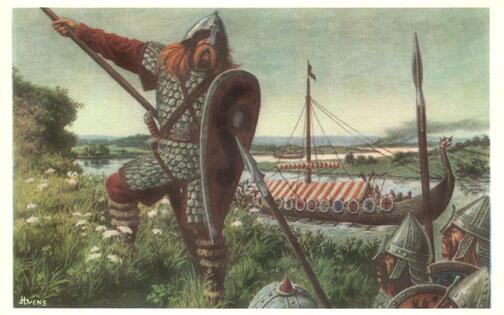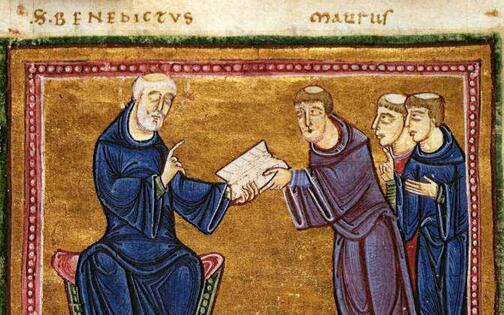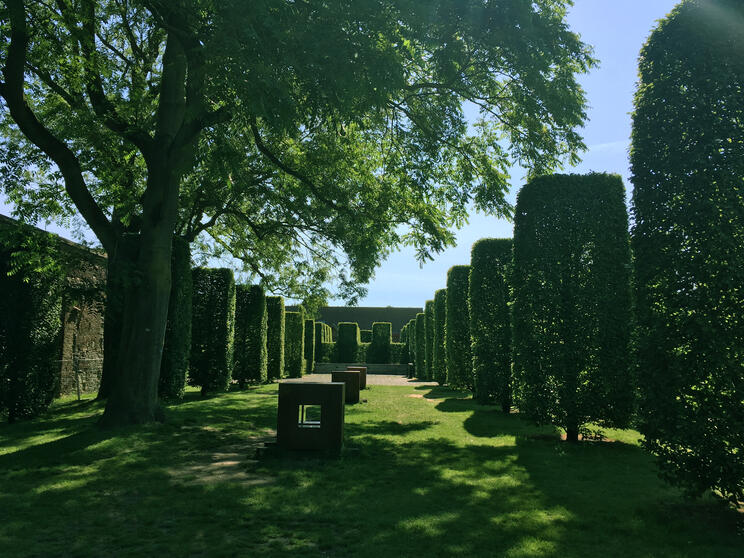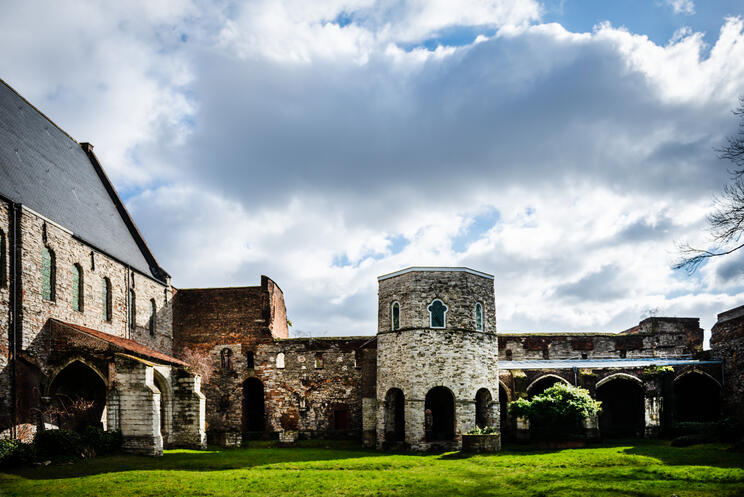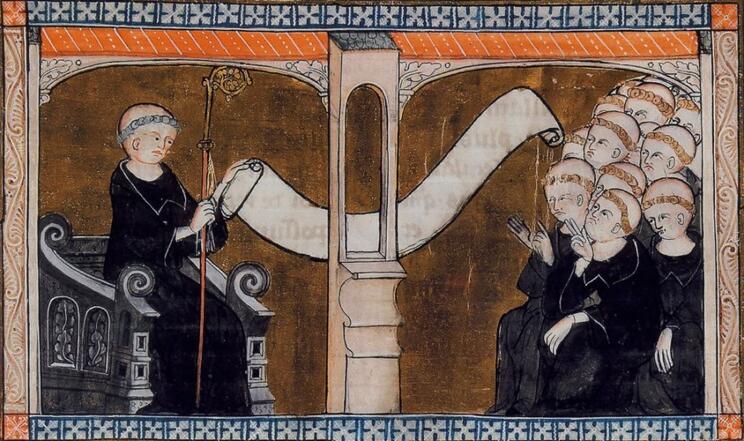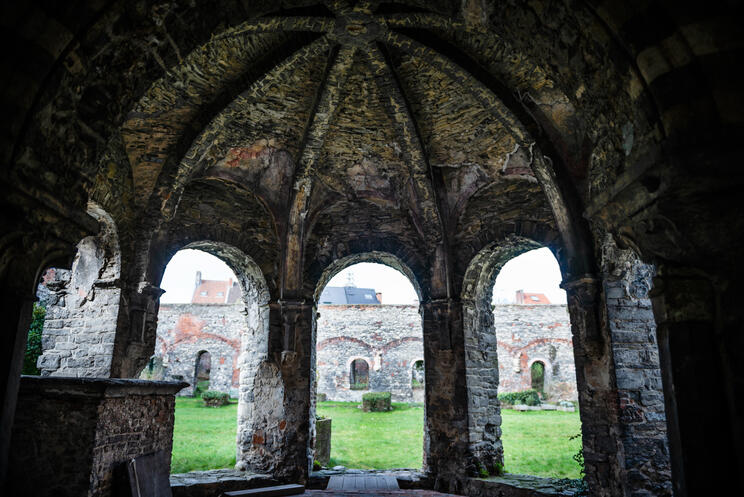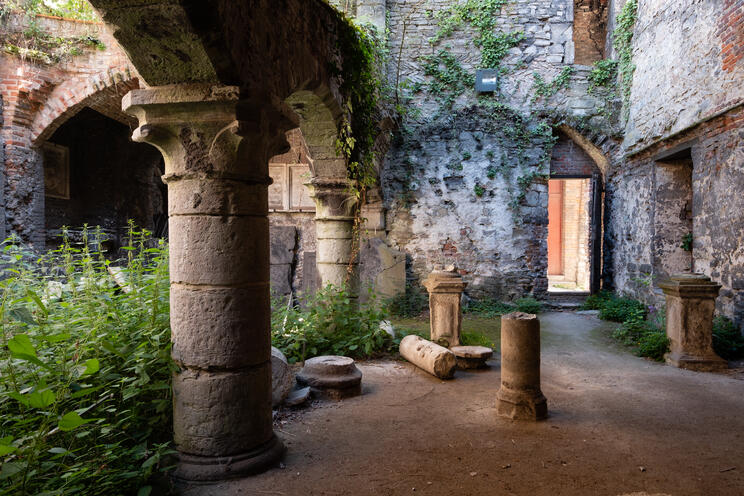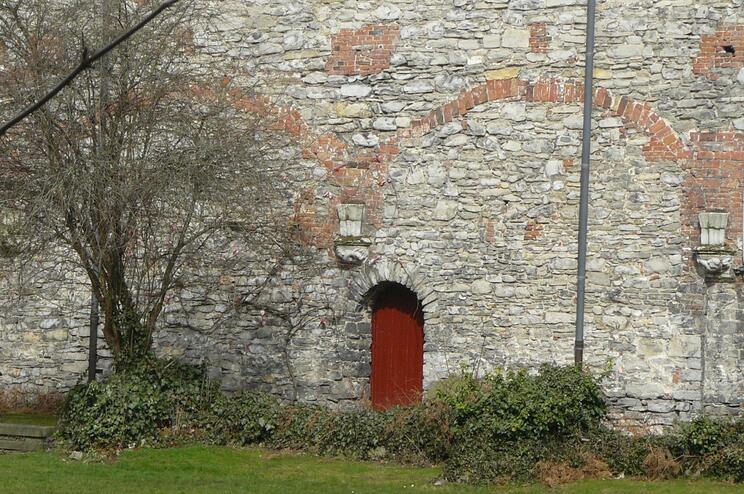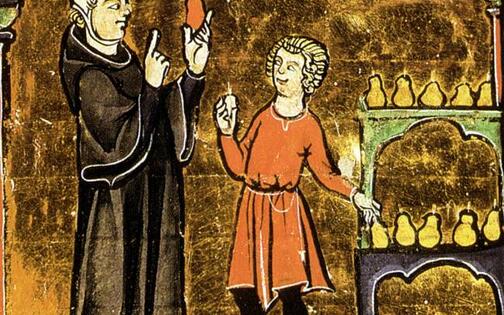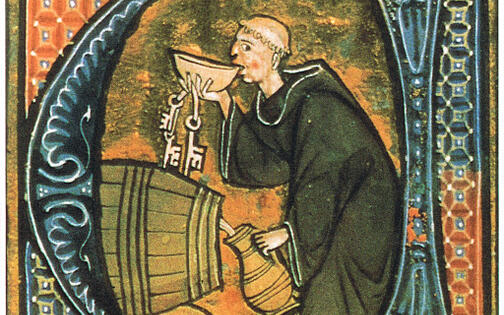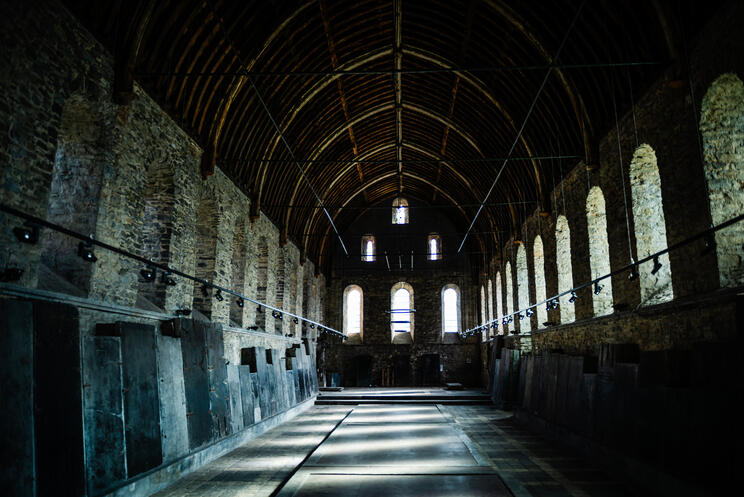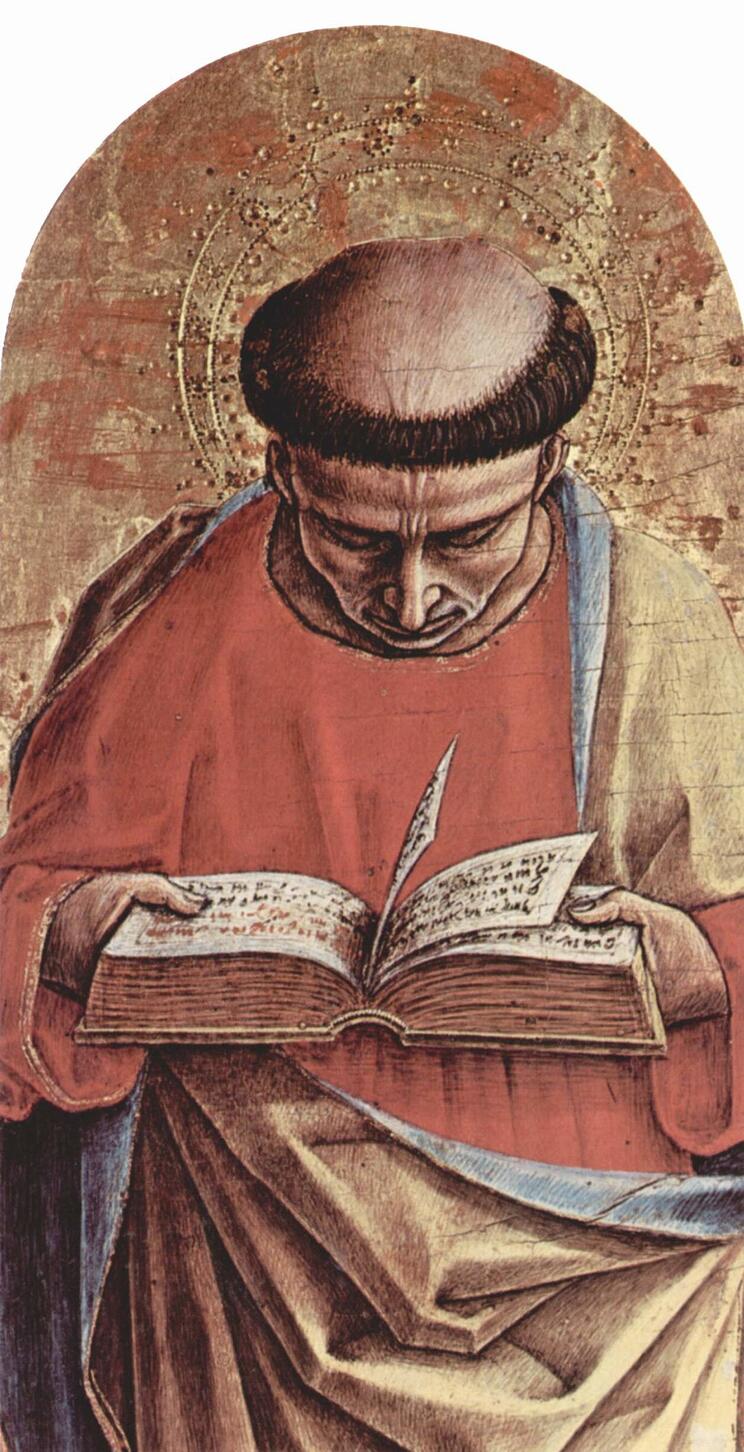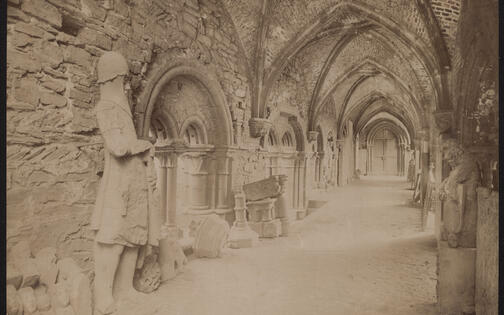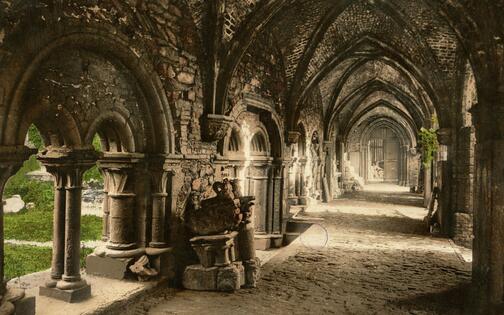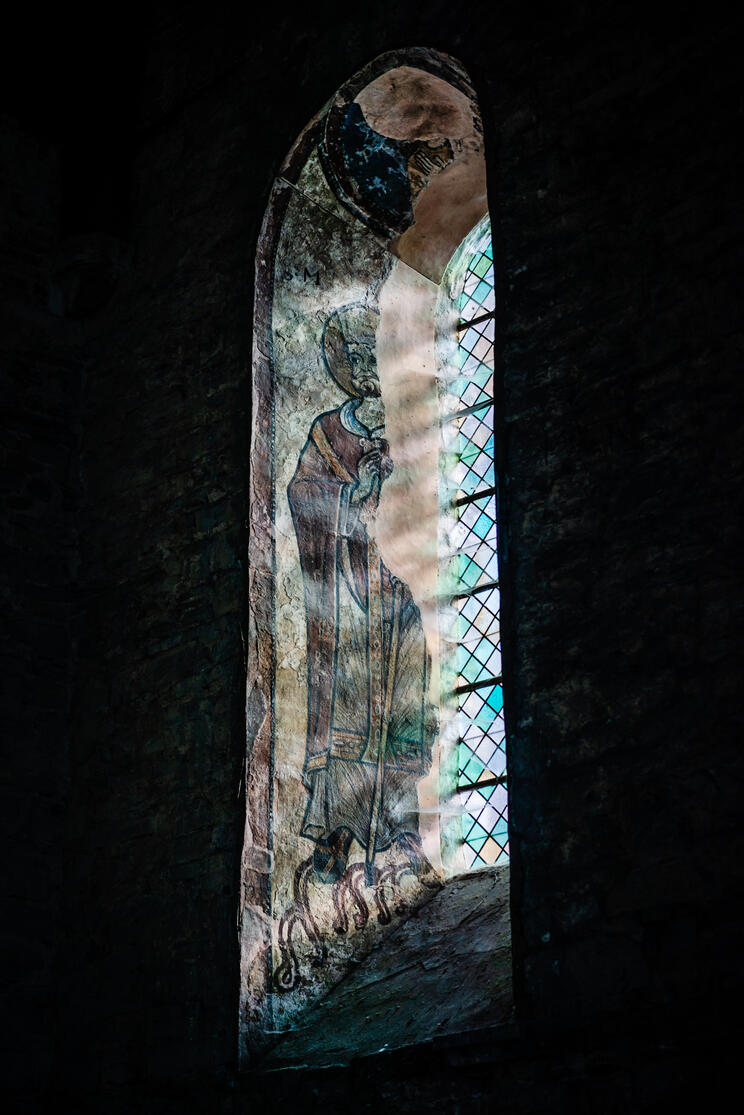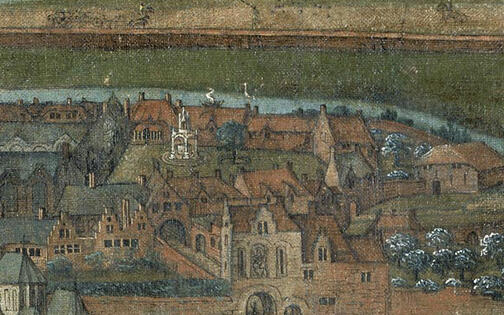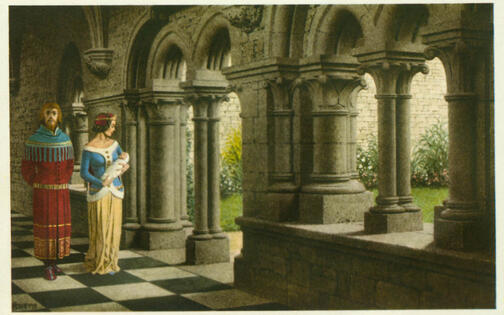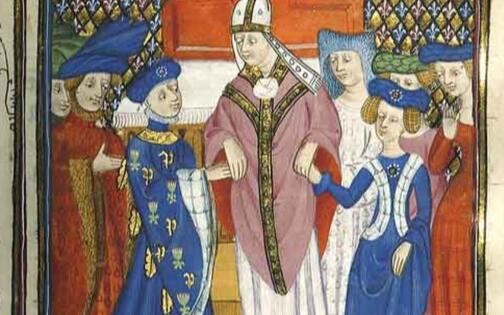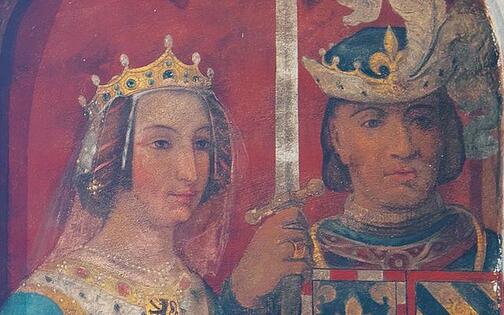
The story of St Bavo’s Abbey
1. Portus Ganda
'Ganda' is the place where the Lys and the Scheldt rivers converge. Around 630, the southern French missionary Amandus founds one of his two Ghent abbeys here. At first, the reaction of the locals to his arrival is rather lukewarm, to say the least. They even throw him – literally - into the river Scheldt. However, the arrival of this tough preacher is a tipping point for many. Bavo, a rich nobleman from Hesbaye, is so impressed by Amandus' actions that he decides to become a hermit and retreats to a hollow tree on the banks of the Scheldt.
When Bavo dies, his remains are placed in the Ganda Monastery, and a popular cult of saints soon arises from which the abbey takes its name. St Bavo's Abbey quickly grows into one of the most powerful abbeys in the region. However, the Vikings soon throw a spanner in the works, as they plunder through our region in the ninth century, even setting up their winter camp here in 880.
-
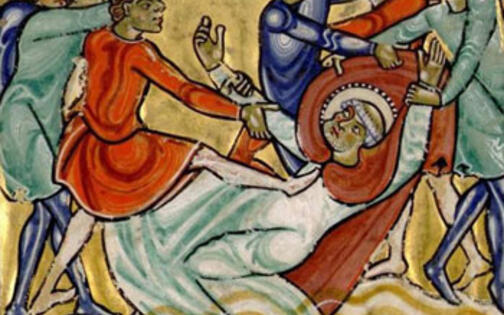
Vijandige bevolking van Ganda werpt Amandus in Schelde. Miniatuur uit : Vita Amandi, handschrift over het leven van de heilige Amandus, ca. 1150-1160, Valenciennes, Bibliothèque municipale -

Amandus tracht de inwoners te bekeren. Miniatuur uit : Vita Amandi, handschrift over het leven van de heilige Amandus, ca. 1150-1160, Valenciennes, Bibliothèque municipale -
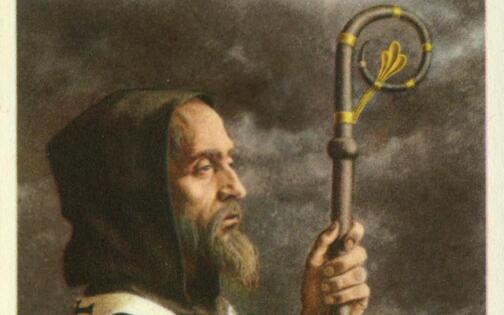
Heilige Amandus. Illustratie uit: ‘Lands Glorie, 1949-1963 -
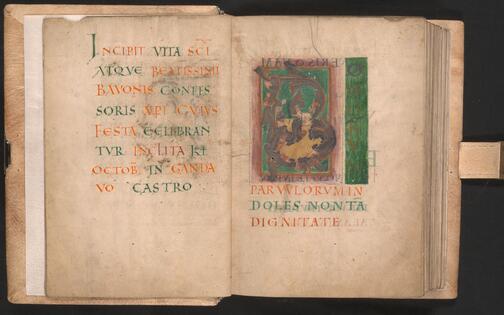
Vita Bavonis of heiligenleven van Bavo, 10de eeuw. Gent, Universiteitsbibliotheek -
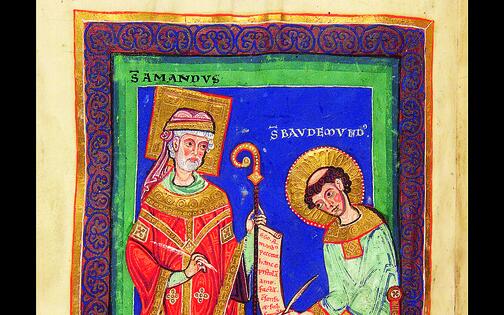
Amandus dicteert zijn testament aan Baudemundus, monnik van Saint-Amand en later abt van de Sint-Pietersabdij. Miniatuur uit: Vita Amandi, handschrift over het leven van de heilige Amandus, ca. 1150-1160, Valenciennes, Bibliothèque municipale -
5 Show all photos
The monks flee, taking the relics from Bavo with them to Laon in France. Only in the middle of the tenth century do they return to a completely destroyed abbey. The reconstruction of the monastery can now begin. From now on, the monks live according to the Rule of Benedict, which meticulously regulates the daily monastic life.
Follow the path to the next QR code and walk on to the stone map a little further on.
2. Green Church
On May 10, 1067, to the chiming of bells and surrounded by plumes of incense and relics of saints, an impressive procession of bishops, abbots and secular dignitaries wearing robes adorned with gold thread and precious stones, strides into this church for a glorious dedication. Even King Philip of France and Count Baldwin V of Flanders are here.
Today, the hornbeam pillars in this 'green church' indicate where the immense abbey once stood. Each hornbeam represents a lost pillar. The stone wall on the left is actually all that is left of this monumental Romanesque building.
Enter the abbey using the entrance through this wall - the 'oldest wall in Ghent', which even incorporates old fragments of recycled Roman roof tiles and bricks.
3. Courtyard
The inner garden or courtyard is the heart of the abbey.
At first, the Romanesque cloister is simply an open construction without any doors or windows, meaning that it often rains in the corridors and inside. The monks therefore wear a thick habit and a warm undergarment. In the fifteenth century, the corridors are fitted with large stained glass windows as protection against wind and weather.
The monks have direct access to the church through the door at the end of this corridor. Walk through the door and bear left.
4. Chapter Room
This is one of the most important and oldest rooms of the abbey: the chapter room, with stone benches surrounding the room and a floor that was once covered with beautiful glazed tiles. The monks meet daily in this meeting room. Here, they make decisions about the daily running of their community.
To the right of the chapter house you can see the sacristy. This is the "scullery" of the church, where the mass is prepared. Nowadays it is hard to imagine, but in the Middle Ages the walls were painted with colourful biblical scenes.
Above the chapter house is the dormitory or bedroom, with small round-arched windows to let in as little light as possible. Every night, one monk stays awake to keep an eye on the time. A few hours after midnight, the monks get up for Matins, the earliest prayer service of the day. There are no fewer than seven services each day.
Now walk on to the octagonal building opposite the chapter house.
5. Lavatorium
Here in the lavatorium, the monks wash their hands before going to the refectory or the church. An ingenious system of pipes, channels, wells and reservoirs supplies the abbey with water from the river Scheldt.
Above the lavatorium is the abbey’s sanctuary, or treasury. It is in this well-hidden room, which is originally only accessible from the dormitory, that the monks keep their most valuable treasures, including relics of saints. These bring in a lot of money for the abbey: relics attract pilgrims, who are more than happy to pay off their sins with donations.
For centuries, the relics of Saint Macharius have been kept here. Macharius is a vagabond who pretends to be a lost bishop from Antioch and finds shelter at the abbey around 1011. He performs a number of miracles and finally dies of a contagious disease himself. This ‘plague saint’ becomes so popular in Ghent that, during the plague epidemic in 1634, it is decided to convert the lavatorium into a Macharius chapel. Today the district around the abbey is still called the Macharius district.
Now leave the lavatorium and continue to the left until you reach QR code 6.
-
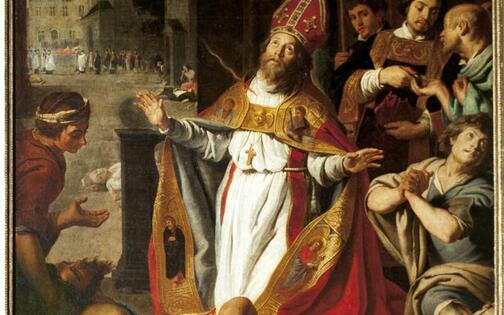
Gaspar De Crayer, Sint-Macharius. Gent, Sint-Baafskathedraal -
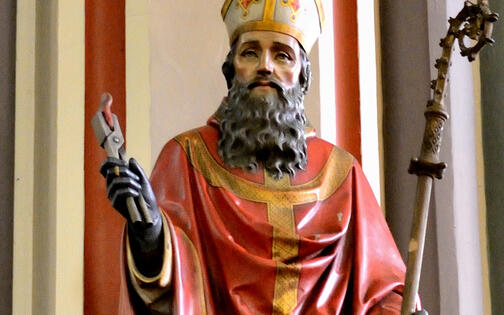
Beeld in de Sint-Lievenkerk te Ledeberg -
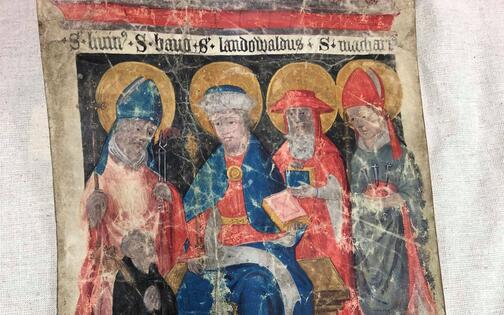
Dodenrol van de Sint-Baafsabdij, 1406-1408, Gent, Rijksarchief. Miniatuur met de vier voornaamste heiligen van de Sint-Baafsabdij: Bavo, Livinus, Landoaldus en uiterst rechts Macharius -
3 Show all photos
6. Scriptorium and Library
During the Middle Ages, the narrow space on the right houses a staircase that leads up to the dormitory on the right and the library and scriptorium on the left. This is where monks copy and decorate manuscripts as well as writing texts themselves. Many manuscripts that were kept here for centuries are now housed in the Ghent university library, including the famous Liber Floridus or “Book of Flowers”, a beautifully illustrated twelfth-century encyclopaedia.
Now continue along the corridor.
-
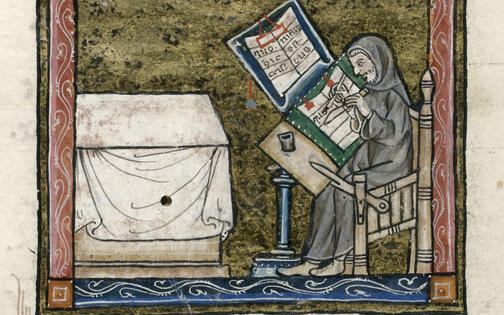
Een monnik aan zijn schrijftafel. Uit: Ermite, 1315-1325, Saint-Omer of Doornik, Londen, British Library -
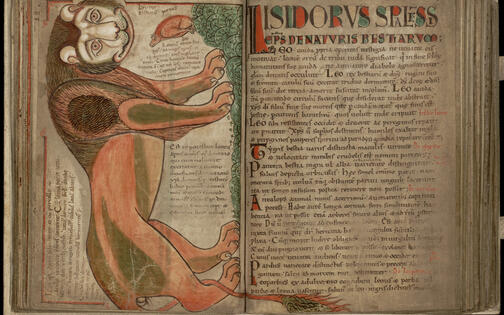
Lambertus van Sint-Omaars, Liber Floridus, 1121. Gent, Universiteitsbibliotheek -
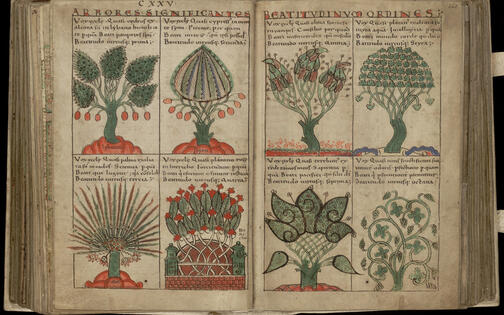
Lambertus van Sint-Omaars, Liber Floridus, 1121. Gent, Universiteitsbibliotheek -
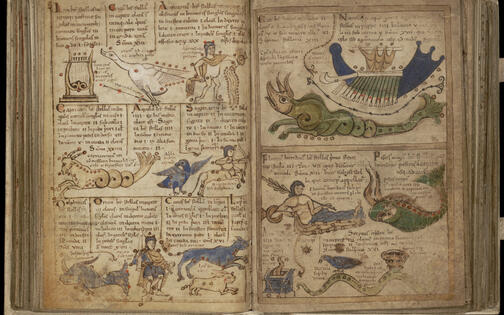
Lambertus van Sint-Omaars, Liber Floridus, 1121. Gent, Universiteitsbibliotheek -
4 Show all photos
7. Stock rooms and Mercatel room
Down here are the abbey’s large store rooms. Only the cellar master has the keys. He is responsible for the distribution the ingredients needed to prepare meals. The storerooms of abbeys are usually well stocked. The abbot regularly receives important guests and on these occasions there are lavish and elaborate banquets.
In 1495, Abbot Raphaël de Mercatel has the store room on the far right converted into a formal reception room with stone benches for guests. Mercatel is one of the many bastard sons of Philip the Good, Duke of Burgundy and ruler of our regions. During this period the abbey is also governed by the dictates of the duke, who appoints his son as abbot in 1478.
Like everyone at the Burgundian court, Raphaël de Mercatel is addicted to entertainment and luxury. He gives the abbey a gothic makeover. He also inherits his love of beautiful books from his father. He collects many manuscripts on history, philosophy, geography, botany and zoology and has new, extravagant manuscripts copied and made, despite the invention and rise of the printing press. After his death, his body, escorted by 100 horsemen, is brought back from his favourite refuge in Bruges to Ghent, where it is buried in the abbey church with great pomp and ceremony.
Now continue to the large refectory, which is located above these cellar rooms.
-

Handschrift uit de bibliotheek van Raphaël de Mercatel, Marcus Tullius Cicero, Rhetorica et de oratore…, 1486-1487, hs. 10. Gent, Universiteitsbibliotheek -
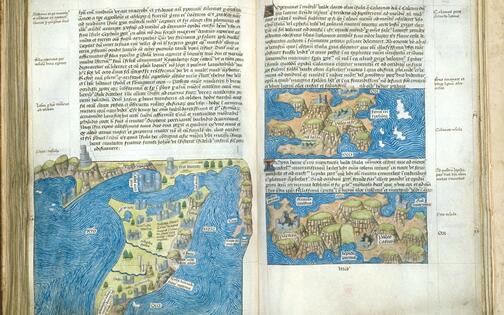
Handschrift uit de bibliotheek van Raphaël de Mercatel, Diodorus Siculus, Biblioteca historiarum, Ms arundel 93. Londen, British Library -
2 Show all photos
8. Refectory and Kitchen
You are now standing in the refectory, a twelfth century Romanesque jewel. This huge space is often used by a mere twenty or thirty monks to eat in. The abbot takes a seat at a separate table. Halfway down the refectory you will notice a niche high up on the inner wall. It is from here that the reader on duty reads aloud during the silent meal.
Today, you can see a large collection of Ghent tombstones on three sides of the refectory. Together with other stone sculptures that you will see scattered around the site, they are a reminder of the Museum of Stone Objects that was housed here in the nineteenth century. Until recently, the tombstone of Hubert Van Eyck's brother was also kept here, but this has now been transferred to the new visitor centre for the Ghent Altarpiece in St Bavo’s Cathedral.
At the rear of the refectory you see three windows. On the far left, the remains of twelfth-century wall paintings showing Saint Macharius can be seen. Opposite him is a holy bishop, presumably Amandus, the founder of the abbey. On the right you see Brictius and Caphraïldis, two characters from the legend of the entirely fabricated saint Livinus or Sint-Lieven. Indeed, there is rivalry for many centuries between the monks of St Bavo and the monks of St. Peter. In the midst of this fierce competition, which rages on until the twelfth century, the rival monks do not hold back, sometimes forging documents and even inventing saints.
Through the large door under the crucifix you enter the abbey kitchen.
Continue through the gate. The narrow path further on, on your right hand-side, will lead you to the well.
9. West Wing and Well
This well is actually a remnant of the St Bavo village, which grew around the abbey from the tenth century.
It is here in the west wing, which has now almost completely disappeared, that the lay brothers find refuge during the Middle Ages. Unlike the monks, they are only occupied with domestic work. Also located here are the rooms where the steward collects the profits from the land and domains belonging to St Bavo's Abbey. The first floor of this building is reserved for frequent guests of the abbey.
Since the thirteenth century, the abbey is often the setting for diplomatic meetings, births, marriages and funerals. In 1340, for example, James van Artevelde invites the English king Edward III and his wife Philippa van Henegouwen here. In the midst of the turbulent 100 Years War, the leader of the Ghent weavers wants to secure the import of the English wool that is desperately needed for the Ghent cloth industry. Due to the unrest in their own country, Edward and his heavily pregnant wife live for some time at St Bavo's Abbey. On March 6, 1340, Philippa gives birth to her fourth son, John of Gaunt, who later becomes Duke of Lancaster.
A few years later, on June 19, 1369, the abbey church is the setting for one of the most sumptuous wedding ceremonies of the time, when Philip the Bold, the first Burgundian duke, marries Margaretha van Male, daughter of the Flemish count. All the important counts and dukes are present at the marriage. The wedding celebration is so lavish that it impresses not only Flanders, but also half of Europe! For days on end, the city is the setting for exuberant parties. It is as a result of this marriage that, after the death of Margaretha's father in 1385, the county of Flanders ends up in the possession of the house of Burgundy. Philip the Bold’s marriage is truly worth its weight in gold!
At this moment it is unimaginable that the strict Catholic Emperor Charles V, the last scion of the Burgundian dukes and native of Ghent, will go on to raze this very church and abbey to the ground in 1540 as punishment for the Ghent revolt...
Now retrace your steps and take the stairs down. Follow the signs to the exit.
